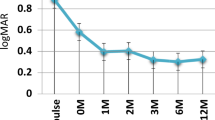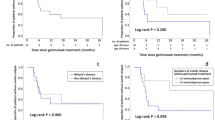Abstract
Background Noninfectious uveitis is usually managed by topical and systemic corticosteroids and in refractory cases by immunosuppressive drugs.
Objective To describe a patient with noninfectious anterior and posterior uveitis, refractory to corticosteroids, and immunosuppressive therapy, which responded to systemic metoprolol.
Patient and methods A 49-year-old patient was treated for 3 years with topical and systemic corticosteroids and systemic cyclosporin A for a bilateral anterior and posterior uveitis of unknown origin. The treatment did not result in resolution of the uveitis. A bilateral uveitic glaucoma developed and necessitated neodymium : YAG laser iridotomies and antiglaucoma medications. A systemic beta-blocker, metoprolol tartrate 50 mg b.i.d., was administered for palpitations because of idiopatic paroxysmal supraventricular tachycardia and short ventricular tachycardia.
Results Following administration of metoprolol tartrate, the bilateral uveitis resolved. The corticosteroids and the cyclosporin A were withdrawn after 6 weeks without any recurrence. A trial to discontinue metoprolol after 6 months resulted in flare-up of the disease and only following its readministration the inflammation resolved. The patient is currently under metoprolol for a year without flare-ups.
Conclusions The use of metoprolol tartrate in this patient resulted in resolution of bilateral noninfectious uveitis. This is the first report of non-antiinfectious, antiinflammatory, or immunosuppressive drug effective for uveitis. It is possible that a subgroup of resistant uveitis may respond to drugs other than the traditional drugs, such as metoprolol, and that other forms of uveitis of unidentified origin exist.
Similar content being viewed by others
Introduction
Uveitis is a group of potentially blinding disorders. The two main categories of uveitis are infectious and noninfectious. The first category is treated by specific antimicrobial drugs, while the second is treated by anti-inflammatory and immunosuppressive drugs.1,2,3 Nevertheless, some noninfectious forms are refractory to all therapeutic modalities, and recognition of new types of uveitis and new drugs would prevent visual loss in severe cases.
We present a case of bilateral uveitis of unknown origin that was resistant to topical and systemic corticosteroids and systemic cyclosporin A, but responded to the systemic beta-blocker metoprolol tartrate. To the best of our knowledge, this response has not yet been reported.
Case report
A 49-year-old white female patient presented to our outpatient clinic 6.5 years ago complaining of an acute decrease in vision and redness in her right eye. Her corrected visual acuity was 20/100 in the right eye and 20/25 in the left. The intraocular pressure (IOP) was 12 and 16 mmHg, respectively. Conjunctival hyperaemia and ciliary injection were noted in the right eye. White cells +3 and flare +2 were found in the right anterior chamber and fine diffuse keratic precipitates on the endothelium. Cystoid macular oedema (CME) and inflammatory cells +3 in the vitreous were noted. No other pathological findings were disclosed in the right eye and the left eye was normal.
The patient was treated with topical dexamethasone sodium phosphate 0.1% q 1 h, cyclopentholate 1% t.i.d., and systemic dexamethasone acetate 1 mg/kg/day with resolution of the uveitis and improvement in visual acuity to 20/40 over a period of 2 weeks. Residual retinal pigment epithelial defects remained after the resolution of the CME. After 2 years, the patient presented with similar signs and symptoms in the same eye. Visual acuity was 20/40 in the right eye and 20/20 in the left. The IOP was 12 mmHg in each eye. Both eyes had flare and cells +2 in the anterior and posterior segments, and posterior synechiae were noted in the right eye. No other ocular pathology was disclosed.
The patient was treated with topical dexamethasone sodium phosphate 0.1% q 1 h, atropine sulfate 1% t.i.d., and systemic dexamethasone acetate 1 mg/kg/day. A repeated review of systems and repeated physical examinations were normal. Repeated extensive laboratory evaluations were normal. These included: complete blood cell count and differential, electrolytes, urine and stool cultures, serology for Brucella, Borrelia burgdorferi, Toxoplasma gondii, and Treponema pallidum (FTA-antibodies), antinuclear antibodies, anticytoplasmatic antibodies, antineutrophil cytoplasmic antibodies, rheumatoid factor, purified protein derivative test, C3 and C4 complements, angiotensin-converting enzyme, cryoglobulins, ANCA, anticardiolipin antibodies, and protein electrophoresis. HLA typing, chest and pelvis X-rays and upper body gallium scans, and evaluation by an internist and dermatologist were also normal. The only remarkable finding was that she had a type-A personality.
Ocular inflammation partially subsided although exacerbation of the inflammation appeared whenever the topical corticosteroids were withdrawn. The patient continued to complain of bilateral ocular pain. Posterior synechiae of 360° developed in both eyes and were treated with subconjunctival injections of atropine sulphate 0.33%, cocaine chloride 1.66%, and adrenaline bitartrate 0.033% (hospital preparation). Systemic corticosteroids were added together with subconjunctival injections of methylprednisolone acetate 40 mg. Despite the intensive treatment, the patient developed pupillary block and closed-angle glaucoma in the left eye and was treated with neodymium : YAG laser iridotomies in each eye and antiglaucoma medications that included oral glycerol 50% 1 mg/kg and topical timoptic maleate 0.5% b.i.d., and aproclonidine HCl 0.5% b.i.d. to the left eye. The IOP in the left eye decreased from 60 to 14–22 mmHg, but visual acuity decreased in this eye to 20/70 because of CME. Since no significant improvement with topical and systemic corticosteroids was noted, systemic cyclosporin A 200 mg × 2/day was added and therapeutic blood levels were kept between 140 and 260 ng/ml. The inflammation failed to resolve and the CME was replaced by epiretinal membrane in the posterior pole. A minimal posterior subcapsular lenticular opacity was noted. Pupillary block and closed-angle glaucoma developed also in the right eye following closure of the iridotomy by the inflammatory process. After repeated laser iridotomy in the right eye and antiglaucoma medications, the IOP decreased from 56 to 10–18 mmHg. The uveitis remained active with white cells and flare +2 despite the intensive treatment with corticosteroids and cyclosporin A for 26 months.
At 3 years after the onset of the bilateral uveitis, the patient complained of palpitations caused by idiopathic paroxysmal supraventricular tachycardia and short ventricular tachycardia. A systemic beta-blocker, metoprolol tartrate (Neobloc®, Unipharm, Trima, Maabarot, Israel) 50 mg b.i.d. was administered. After a week, a remarkable decrease in the intraocular inflammation in both eyes was noted to occur with the resolution of the cardiac arrhythmia. Topical and systemic corticosteroids and systemic cyclosporin A were withdrawn after 6 weeks without flare-up over a follow-up of 6 months. During this period, almost no cells or flare were noted in the anterior and posterior segments of each eye. A trial to discontinue the administration of metoprolol after 6 months resulted in a flare-up of the uveitis and white cells and flare +2 were noted again in each eye after a week. Metoprolol therapy was reinstituted and resulted in a regression of the uveitis in both eyes a week after the retreatment. The patient is currently treated with metoprolol tartrate 50 mg × 2/day for a year without flare-up of the disease. During treatment with metoprolol and the withdrawal period, the IOP was in the teens without antiglaucoma medications and without substantial fluctuations. No side effects were encountered with the use of metoprolol.
Comment
The aetiology of the uveitis in our patient was not established despite extensive review of systems, physical examination, and extensive laboratory work-up. Moreover, the uveitis did not respond to topical and systemic corticosteroids or to systemic cyclosporin A and the patient experienced CME and pupillary block glaucoma and posterior subcapsular cataract.
The uveitis in our patient responded to a systemic nonselective beta-blocker, metoprolol tartrate, which was given for cardiac arrhythmia. This response could be merely a coincidence, a placebo effect, or a response to the drug. The flare-up of the disease following a discontinuation of metoprolol and its suppression following reinstitution of the drug suggest the association between the administration of the drug and the resolution of the uveitis. A second withdrawal was not tried because of the severity of the uveitis before its initiation. A placebo effect was unlikely since the drug was given for cardiac arrhythmia and not for the uveitis. Therefore, a pharmacological beneficial effect of metoprolol in uveitis is a possibility that merits investigation.
Although many patients are on systemic beta-blockers and may also have uveitis, a response of uveitis in these patients has never been reported. This may be explained by physician inattention, use of different beta-blockers and different dosage, attributing the response to antiuveitic agents, and by different individual susceptibilities to the drug.
Beta-adrenergic receptors have been identified in the human iris and ciliary body. Approximately 90% of the beta-adrenergic receptors are of subtype beta2 and 10% are of subtype beta1.4 Activation of beta2 receptors increase the formation of cyclic adenosine monophosphate and stimulation of Na+, K+ Cl− cotransport in the fetal nonpigmented ciliary epithelium.5 Such activation may occur via endothelin 1 secreted from the ciliary muscle cells.6 The role of the beta-adrenergic receptors in uveitis however has not been investigated, although the active isopropyl side chain or the amine group of metoprolol may theoretically be served as side chains in immunosuppressive drugs such as alkylating agents. The resolution of the uveitis following the administration of metoprolol tartrate in a specific dosage and the evidence that metipranolol, another beta-blocker, may cause uveitis,7 advocate further clinical and basic studies to establish the role of these receptors in uveitis. Our patient had type-A personality and her uveitis' response to metoprolol resembles the association between central serous chorioretinopathy and type-A personality8 and its possible response to beta-blockers.9
Although the patient's response to metoprolol may be an exceptional, it is possible that certain patients with uveitis, which is refractory to anti-inflammatory and immunosuppressive therapy, may respond to metoprolol or other specific drugs. Definition of other types of uveitis and their response to specific drugs such as metoprolol may prevent serious side effects, which are frequently encountered with corticosteroid and immunosuppressive therapy and provide new armament for refractory uveitis.
References
Hemady R, Tauber J, Foster CS . Immunosuppressive drugs in immune and inflammatory ocular disease. Surv Ophthalmol 1991; 35: 369–385.
Bierly JR, Nozik RA . Management of uveitis. Curr Opin Ophthalmol 1992; 3: 527–533.
Dick AD, Azim M, Forrester JV . Immunosuppressive therapy for chronic uveitis: optimizing therapy with steroids and cyclosporin A. Br J Ophthalmol 1997; 81: 1107–1112.
Wax MB, Molinoff PB . Distribution and properties of beta-adrenergic receptors in human iris-ciliary body. Invest Ophthalmol Vis Sci 1987; 28: 420–430.
Crook RB, Riese K . Beta-adrenergic stimulation of Na+, K+, Cl− cotransport in the fetal non-pigmented ciliary epithelial cells. Invest Ophthalml Vis Sci 1996; 37: 1047–1057.
Prasanna G, Dibas AI, Yorio T . Cholinergic and adrenergic modulation of the Ca+ response to endothelin-1 in human ciliary muscle cells. Invest Ophthalmol Vis Sci 2000; 41: 1142–1148.
Melles RB, Wong IG . Metipranolol-associated granulomatous iritis. Am J Ophthalmol 1994; 18: 712–715.
Yannuzzi LA . Type A behavior and central serous chorioretinopathy. Trans Am Ophthalmol Soc 1986; 84: 799–845.
Fabianova J, Porubska M, Cepilova Z . Centralona serozna chorioretinopatia—liecba betabokatormi. Cesk Slov Oftalmol 1998; 54: 401–404.
Author information
Authors and Affiliations
Rights and permissions
About this article
Cite this article
Kassif, Y., Rehany, U. & Rumelt, S. Metoprolol responding uveitis. Eye 18, 41–43 (2004). https://doi.org/10.1038/sj.eye.6700507
Received:
Accepted:
Published:
Issue Date:
DOI: https://doi.org/10.1038/sj.eye.6700507
Keywords
This article is cited by
-
Metoprolol responding uveitis
Eye (2005)



